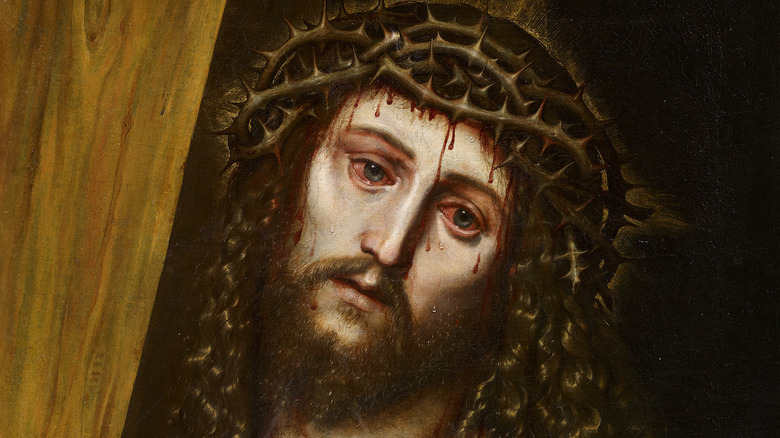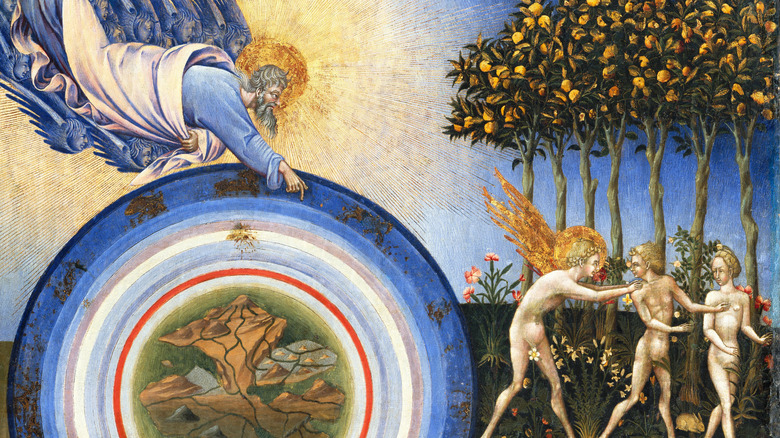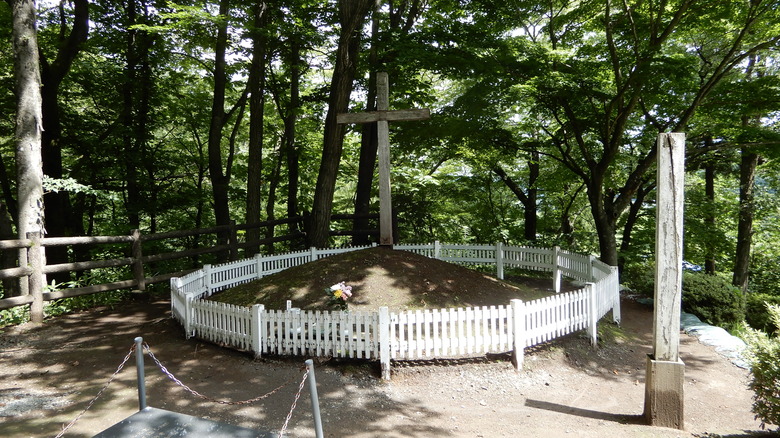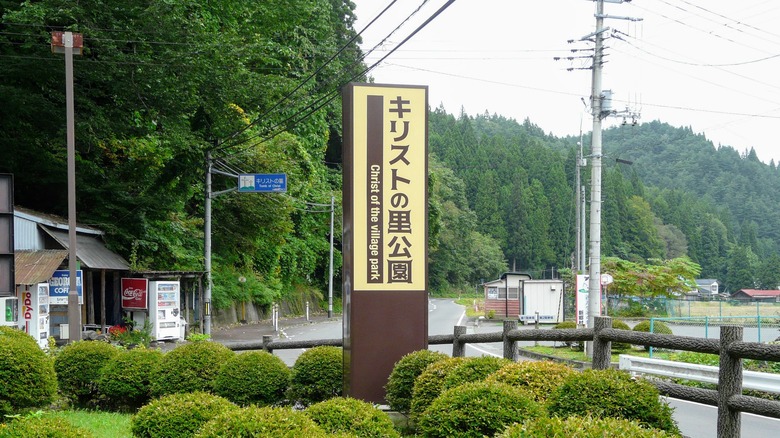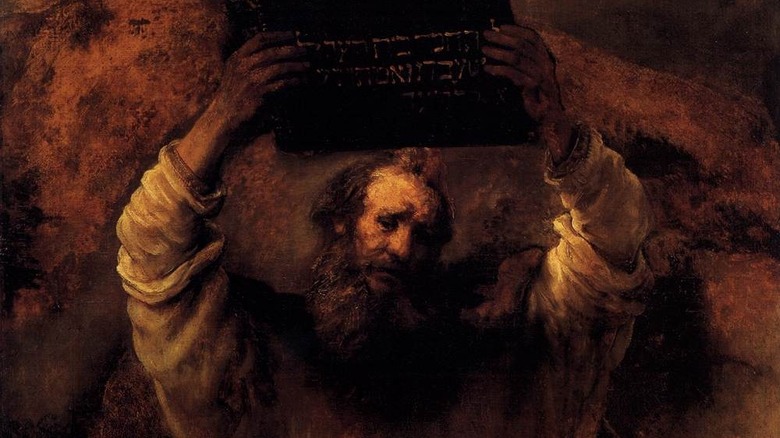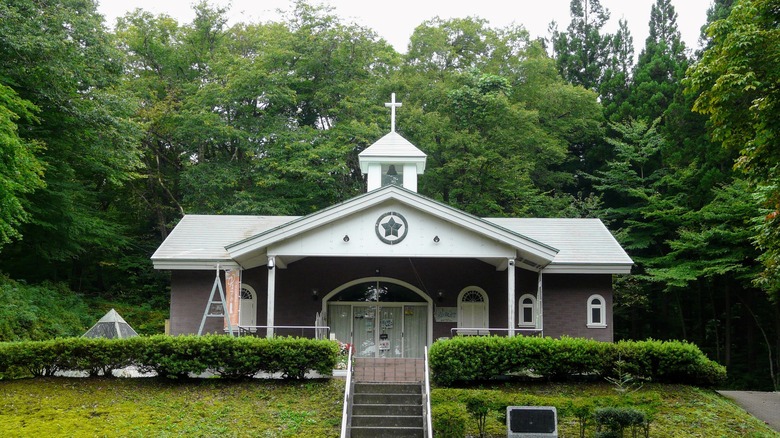The Takenouchi Manuscripts Provide An Entirely New Story For Jesus Christ
The world is full of accounts of the life of Jesus Christ, from the four canonical gospels of the New Testament, to a host of apocryphal texts from late antiquity and the medieval period, to modern takes like Christopher Moore's humorous novel "Lamb: The Gospel According to Biff, Christ's Childhood Pal." But among these numerous takes, there are certain details that generally tend to remain constant, like the idea that Jesus was born in Bethlehem, or that his ministry was in Judea, or that he was crucified. There is one set of documents, however, that tells us that these texts got the life of Jesus all wrong. In fact, these texts say that everyone has gotten everything about the entire history of the universe wrong.
The Takenouchi Manuscripts, or Takenouchi Documents, are — as Ancient Origins explains — a set of manuscripts whose adherents claim were translated 1,500 years ago into a mixture of modern Japanese and Chinese characters by a man named Takenouchino Matori, who transliterated a set of even older texts that were written in "divine characters" by the gods millennia ago. The text of the manuscripts themselves claims to tell the secret history of humankind from creation until the beginning of the Christian era.
The secret history of the world
Although the life of Jesus as related in the Takenouchi Manuscripts may be the part of particular interest to English speakers, there is a lot more to them. According to Ancient Origins, the cosmic history laid out in the documents says that the world was originally nothing but a great expanse of mud, coalescing slowly over the course of 22 billion years. Eventually, the gods and goddesses emerged and separated the earth from the sky and formed the sun and the moon. Pretty standard creation story stuff as far as all that goes. Over the course of multiple generations, the gods evolved and created technologies such as writing and agriculture. Billions of years later, the gods dispersed across the various nations and created humans, which were divided into five colors: white, red, blue, yellow, and black. Japan was made the center of the universe.
The world was ultimately united under a single government by the god-emperor Sumera-Mikoto, who divided the world into 16 districts like the petals of a chrysanthemum flower and would tour the land in a flying ship. Sumera-Mikoto built the pyramids in Egypt as a way to communicate with the gods. As is inevitable in most creation stories, however, humans began to disobey the gods, who retaliated by sinking two continents in the Pacific Ocean. The documents claim that many such catastrophes have occurred across history due to the arrogance of humankind.
Jesus' second life in Japan
As Ancient Pages explains, in addition to explaining the history of the grand civilization of Sumera-Mikoto's worldwide empire, the Takenouchi Documents also tell the history of the masters born from each of the five colors of humankind, which the manuscripts name as Moses, Jesus, Mohammed, Shakyamuni Buddha, Confucius, and Lao-Tsu. According to Slate, the life story of Jesus told within these documents differs pretty substantially from what you might have learned in Sunday school or from "VeggieTales." While the New Testament says that Jesus grew up in Nazareth and began his ministry at about the age of 30, the Takenouchi Documents say that Jesus left Judea for Japan at the age of 21, where he studied for 12 years, returning to Judea at age 33 to begin his ministry.
As in the Bible, the Takenouchi Jesus received resistance from the people for his teachings and found himself in trouble with the Roman authorities. Unlike Bible Jesus, however, Takenouchi Jesus had a brother, Isukiri, who volunteered to pose as Jesus and take his place on the cross. Thus it was actually Jesus' brother who was crucified, while the real Jesus returned to Japan, where he married, had three daughters, and lived as a simple rice farmer until the age of 106, dying of natural causes. Smithsonian Magazine says that Jesus spent his time in Shingo helping those in need, and over time he developed a balding head with gray hair and a nose of such a shape that the local villagers called him a "long-nosed goblin."
The Japanese tomb of Jesus
"Sure," you might say, "a set of documents might claim that Jesus lived and died in a small village in Japan rather than dying on a cross in Roman Judea, but is there any material evidence for such a shocking assertion?" Well, according to the people of the village of Shingo in Japan's Aomori Prefecture, yes, there is. For some time now, Shingo has advertised itself as the true final resting place of Jesus Christ (via Atlas Obscura). The Japanese tomb of Jesus is a burial mound on the top of a hill with a cross on the top and a small fence surrounding it. Nearby is another, smaller mound, which is said to hold a lock of hair from the Virgin Mary and one of the ears of Isukiri, Jesus' little brother who died in his place and also apparently gave him one of his ears.
Much of this is explained in the nearby Jesus museum that contains replicas of the Takenouchi Documents themselves, which are said to have been destroyed during World War II. In addition to the manuscripts themselves, the burial mound, the lock of hair, and the severed ear, some residents of Shingo point to many of the village's inhabitants — who say that they are descended from Jesus himself — as proof of Jesus' residence. They also underline that the people of Shingo have different dialects and eye colors from surrounding villages and cite this as proof of Christian blood.
Moses' other commandments
Jesus, however, is not the only figure in the Takenouchi Documents that would be recognizable to readers of the Bible. As Gizmodo explains, the manuscripts say that following the revelation of the 10 commandments to the Israelites at Mount Sinai, Moses boarded a spaceship and flew across the world to Japan. Once he arrived there, he delivered to the people there a set of 10 new commandments, many of which appear to contradict the more famous ones he brought down from the mountain to the Israelites. These new commandments include worshiping the Japanese gods, worshiping the emperor, protecting the laws of the five races, and worshiping the spirit kami. This is, you might notice, quite a lot of worshiping entities that are not the God who brought the Israelites out of Egypt. So it goes. As Smithsonian Magazine adds, Moses had received the original commandments — as well as the Hebrew language and the Star of David — from the god-emperor of Japan.
At any rate, Moses lived to the ripe old age of 583, nearly six times the life span of Jesus. As with Jesus, however, he is also buried in Japan, and his grave has likewise become a tourist destination. The Japanese Tomb of Moses can be found in Ishikawa Prefecture, near Mount Houdatsu, with the burial mounds of his family located nearby.
Where did these manuscripts come from?
The Takenouchi Manuscripts are obviously extremely interesting, with an alien-laden secret history of the world that gives a look at the lives of notable people in a way rarely seen before, but obviously the question of how reliable or authentic they are depends on where they came from. As Ancient Origins explains, the official claim of the foundation behind the documents is that the divine documents were transliterated into modern script over 1,500 years ago by Takenouchino Matori — the son of the great Japanese hero Takenouchi no Sukune — and subsequently preserved and kept by the descendants of the Takenouchi family over generations. According to Slate, the official narrative goes on to say that these documents were eventually discovered in the 1930s by a group of Japanese archaeologists, only to be destroyed during World War II. Fortunately, replicas like the ones in the museum in Shingo were created first.
Atlas Obscura explains, however, that it is extremely likely that the documents were a hoax created by a man named Wado Kosaka, a so-called cosmoarcheologist who wasn't even born until 1947, according to the bio on the Takenouchi Documents webpage. Wado also gained a certain amount of notoriety by trying to make contact with a UFO on live television. He died at the age of 54 in 2002, after which the control of the Association for the Study of the Takenouchi Documents was passed on to his wife, Michiyo Miwa.
